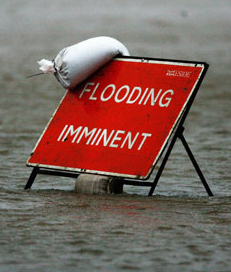Climate costs high either way, inaction won't help
 Floods and fires will leave Australia with a mind-boggling damage bill in coming years, the CSIRO says.
Floods and fires will leave Australia with a mind-boggling damage bill in coming years, the CSIRO says.
Meanwhile, one Queensland council has had its hand forced into a climate change-denying position.
As Sydney and Brisbane continue mopping-up from severe storms, the CSIRO has predicted damage caused by extreme weather could cost Australia more than $1 trillion.
The nation's top science agency says increased climate variability and poor planning will leave Australia increasingly exposed.
In a draft CSIRO discussion paper reported by the ABC this week, the experts say the cost of replacing buildings after bushfires, inland flooding and coastal inundation could almost double by 2100.
That would leave the bill at a staggering $1.38 trillion.
“All evidence suggests that the current trend of increasing disaster costs will continue into the future with a direct impact on Commonwealth expenditure,” the CSIRO papers said.
“Climate change is likely to increase this trend in the longer term for many hazards.”
University of New South Wales Climate scientist Professor Andy Pitman told reporters that much of the problem comes from poor planning decisions.
On exactly that note, Queensland Deputy Premier Jeff Seeney has forced the removal of all references to climate change-derived sea level rises in planning papers for Moreton Bay Regional Council.
In a letter to the council, Mr Seeney wrote: “I direct council to amend its draft planning scheme to remove any assumption about a theoretical projected sea level rise from all and any provision of the scheme.”
By law, the council must uphold Seeney’s directive.
It has forced the Local Government Association of Queensland (LGAQ) to seek legal advice on behalf of the state’s councils.
They are concerned that they could face serious liabilities for not taking climate change into consideration in local planning.
With more development likely for hazardous coastal areas, and therefore more people affected by sea level rise, the fears are well-founded.
Brisbane, Sunshine Coast and Townsville have also used the conservative assumption of a 0.8-metre rise in sea level by the year 2100 in their planning,
The estimate is based on a depth of science research well beyond any conducted by the Deputy Premier.
But still, Mr Seeney wants the reference removed in Moreton Bay.
A report included in the agenda of a Moreton council meeting this week said; “Council noted the Deputy Premier's concerns but indicated the inclusion of climate change factors, including sea level rise, based on the best scientific and technical information available to the council, was necessary in order to protect the council against legal liability.”
Mr Seeney told the ABC that he stepped in “to ensure residents' rights to build and develop their properties were maintained and not restricted by their local council”.
The move does appear to be in the opposite direction from Seeney’s formerly stated position.
A letter from the Deputy Premier to Moreton Bay Mayor Allan Sutherland in January allegedly said “each coastal local government should proceed to determine the extent of coastal hazards in the manner that it considers appropriate and plan accordingly”.







 Print
Print